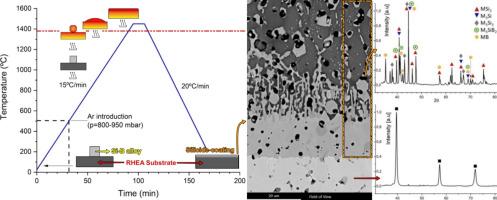通过反应熔渗合成复杂的浓缩硅化物涂层:探索 Si-B 熔体与 MoNbTaW 高熵合金之间的界面现象
IF 5.3
2区 材料科学
Q1 MATERIALS SCIENCE, COATINGS & FILMS
引用次数: 0
摘要
高熵硅化物(HES)涂层是解决金属耐火合金抗氧化性差问题的一种很有前途的方法。然而,其实际发展仍处于早期阶段。本研究首次评估了使用反应熔体渗透法合成复杂浓缩硅化物涂层的可行性。为此,我们进行了一次无梗滴实验,将二元共晶硅硼合金(Si8B at.%)与钼铌钽瓦难熔高熵合金(RHEA)基材进行接触加热,温度最高可达 1450 ℃。高温试验结束后,通过 X 射线衍射、扫描电子显微镜与能量色散 X 射线光谱、电子反向散射衍射系统和显微硬度技术对凝固耦合物进行了表征。涂层的平均厚度为 75 μm,由不同的层组成,包括原生 MSi2 层、过渡 MSi2 + M5Si3 硅化物层和 M5Si3 硅化物(M = 金属)。此外,硼硅化物和硼化物颗粒也分散在各层中。不过,未来的研究应优先考虑改进工艺参数,以消除孔隙并提高涂层的完整性。本文章由计算机程序翻译,如有差异,请以英文原文为准。

Synthesis of complex concentrated silicide coatings via reactive melt-infiltration: Exploring interfacial phenomena between Si-B melt and MoNbTaW high-entropy alloy
High-entropy silicide (HES) coatings are a promising solution to the problem of poor oxidation resistance of metallic refractory alloys. However, their practical development is still in the early stages. For the first time, this study evaluates the feasibility of synthesizing complex concentrated silicide coatings using a reactive melt infiltration approach. For this purpose, a sessile drop experiment was carried out in which a binary eutectic silicon‑boron alloy (Si![]() 8B at.%) was subjected to contact heating with the MoNbTaW refractory high entropy alloy (RHEA) substrate at temperatures up to 1450 °C. After the high-temperature test, the solidified couple was characterized by X-ray diffraction, scanning electron microscopy coupled with energy-dispersive X-ray spectroscopy, electron backscatter diffraction systems, and microhardness techniques. The coating had an average thickness of 75 μm and was composed of different layers, including a primary MSi2 layer, a transition MSi2 + M5Si3 silicide layer, and M5Si3 silicides (M = metal). Additionally, borosilicides and boride particles were dispersed throughout the layers. However, future research should prioritize refining process parameters to eliminate porosity and improve the integrity of the coating layer.
8B at.%) was subjected to contact heating with the MoNbTaW refractory high entropy alloy (RHEA) substrate at temperatures up to 1450 °C. After the high-temperature test, the solidified couple was characterized by X-ray diffraction, scanning electron microscopy coupled with energy-dispersive X-ray spectroscopy, electron backscatter diffraction systems, and microhardness techniques. The coating had an average thickness of 75 μm and was composed of different layers, including a primary MSi2 layer, a transition MSi2 + M5Si3 silicide layer, and M5Si3 silicides (M = metal). Additionally, borosilicides and boride particles were dispersed throughout the layers. However, future research should prioritize refining process parameters to eliminate porosity and improve the integrity of the coating layer.
求助全文
通过发布文献求助,成功后即可免费获取论文全文。
去求助
来源期刊

Surface & Coatings Technology
工程技术-材料科学:膜
CiteScore
10.00
自引率
11.10%
发文量
921
审稿时长
19 days
期刊介绍:
Surface and Coatings Technology is an international archival journal publishing scientific papers on significant developments in surface and interface engineering to modify and improve the surface properties of materials for protection in demanding contact conditions or aggressive environments, or for enhanced functional performance. Contributions range from original scientific articles concerned with fundamental and applied aspects of research or direct applications of metallic, inorganic, organic and composite coatings, to invited reviews of current technology in specific areas. Papers submitted to this journal are expected to be in line with the following aspects in processes, and properties/performance:
A. Processes: Physical and chemical vapour deposition techniques, thermal and plasma spraying, surface modification by directed energy techniques such as ion, electron and laser beams, thermo-chemical treatment, wet chemical and electrochemical processes such as plating, sol-gel coating, anodization, plasma electrolytic oxidation, etc., but excluding painting.
B. Properties/performance: friction performance, wear resistance (e.g., abrasion, erosion, fretting, etc), corrosion and oxidation resistance, thermal protection, diffusion resistance, hydrophilicity/hydrophobicity, and properties relevant to smart materials behaviour and enhanced multifunctional performance for environmental, energy and medical applications, but excluding device aspects.
 求助内容:
求助内容: 应助结果提醒方式:
应助结果提醒方式:


